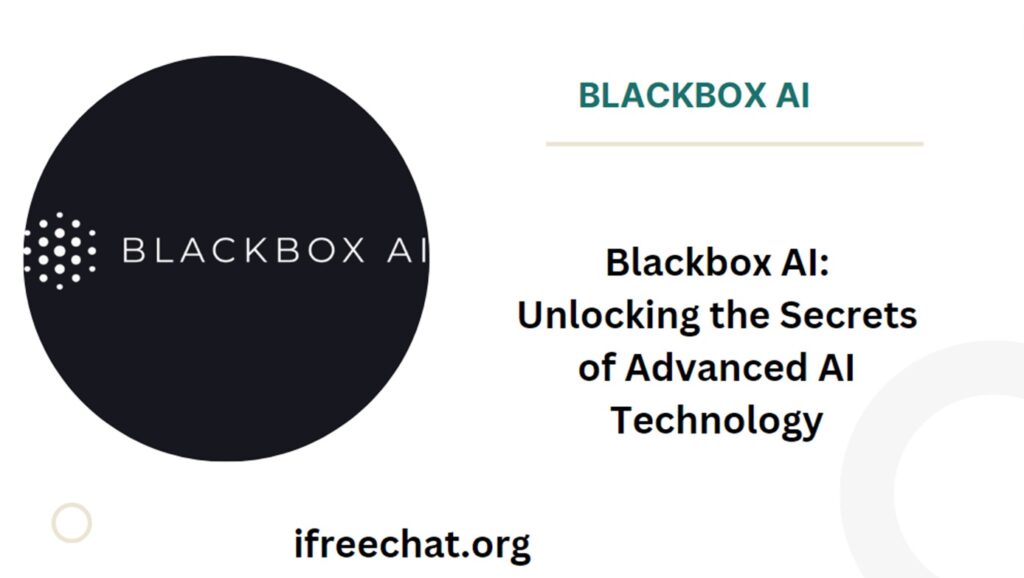
blackbox ai
Artificial Intelligence (AI) is transforming various sectors by enabling advanced data processing and decision-making capabilities. Among AI technologies, Blackbox AI stands out due to its powerful yet opaque nature. This comprehensive guide aims to elucidate what Blackbox AI is, how it functions, its applications, benefits, challenges, and the best practices for using it effectively.
Table of Contents
1. Introduction to Blackbox AI
Definition and Overview
Blackbox AI refers to AI systems whose internal mechanisms are not visible or easily understandable to users. These systems take inputs and provide outputs without revealing the internal decision-making processes. This opaqueness is due to the complexity and proprietary nature of the algorithms used.
Historical Context and Evolution
The term “black box” originally comes from engineering and aviation, describing systems where inputs and outputs are known, but the internal workings are not. In AI, the concept gained prominence with the rise of complex machine learning and deep learning models, which can be too intricate for human comprehension.
2. Mechanics of Blackbox AI
The “Black Box” Concept
A blackbox AI system processes input data and generates outputs, but the processes in between are hidden. This lack of transparency makes it challenging to understand how decisions are made, which can be a drawback in critical applications requiring accountability.
Machine Learning and Deep Learning Frameworks
Blackbox AI primarily uses machine learning (ML) and deep learning (DL) techniques. ML involves training algorithms on data to recognize patterns and make predictions. DL, a subset of ML, uses neural networks with multiple layers to handle more complex tasks.
Key Algorithms and Models
- Neural Networks: Comprising interconnected nodes, these are modeled after the human brain and are pivotal in deep learning.
- Support Vector Machines (SVM): Effective for classification and regression tasks.
- Random Forests: These use multiple decision trees to enhance prediction accuracy.
3. Practical Applications of Blackbox AI
Healthcare Sector
In healthcare, Blackbox AI assists in diagnostic imaging, personalized treatment plans, and predictive analytics. For example, AI can analyze MRI scans to detect early signs of diseases that might be overlooked by human eyes.
Financial Industry
The financial sector leverages Blackbox AI for fraud detection, credit scoring, and algorithmic trading. These systems analyze vast amounts of financial data to identify patterns and predict market movements.
Manufacturing Processes
In manufacturing, Blackbox AI optimizes supply chain management, predictive maintenance, and quality control. AI systems predict equipment failures and recommend maintenance schedules, reducing downtime and costs.
Customer Service Enhancements
Blackbox AI powers chatbots and virtual assistants that handle customer inquiries, process transactions, and provide personalized recommendations, enhancing customer satisfaction and reducing operational costs.
4. Advantages of Blackbox AI
Enhanced Efficiency and Precision
Blackbox AI can process and analyze data faster and more accurately than humans, leading to increased efficiency and precision in various tasks.
Scalability and Flexibility
These AI systems can easily scale to handle more data and complex tasks, making them ideal for growing businesses and evolving industries.
Superior Decision-Making Support
By analyzing large datasets, Blackbox AI provides valuable insights that support decision-making, uncovering patterns and trends that might not be apparent to human analysts.
5. Challenges and Limitations
Transparency Issues
The primary challenge of Blackbox AI is its lack of transparency. Users cannot see how decisions are made, leading to trust issues and difficulty in diagnosing errors.
Ethical Implications
Ethical concerns, particularly regarding bias and fairness, are significant. Since AI learns from data, it can perpetuate existing biases present in the training data.
Data Dependency
Blackbox.AI requires large amounts of high-quality data to function effectively. This dependency can be limiting in situations where data is scarce or of poor quality.
6. Implementing Blackbox AI
Setting Up the Environment
To implement Blackbox.AI, ensure you have the necessary infrastructure, including:
- Hardware: Powerful CPUs/GPUs for data processing.
- Software: AI frameworks like TensorFlow, PyTorch, or Keras.
- Data: High-quality, labeled datasets relevant to your application.
Data Preparation Techniques
Data preparation involves cleaning, transforming, and labeling your data. High-quality data is crucial for training effective AI models.
Training and Testing Models
Training involves feeding data into the AI model and allowing it to learn from patterns. After training, the model is tested on a separate dataset to evaluate its performance.
Deployment and Integration Strategies
Post-testing, the model is deployed in a real-world environment. This involves integrating the AI system with existing infrastructure and ensuring seamless operation.
7. Best Practices for Blackbox AI Utilization
Ensuring High-Quality Data
Accurate AI predictions require high-quality data. Ensure your data is clean, relevant, and representative of the problem you are solving.
Continuous Monitoring and Updating
Regularly monitor AI models to ensure they perform well and update them as new data becomes available to maintain accuracy.
Addressing Ethical and Bias Concerns
Implement measures to address ethical concerns, such as:
- Bias Detection: Regularly check and mitigate biases in AI models.
- Transparency Efforts: Utilize explainable AI techniques to provide insights into model decisions where possible.
8. Future Prospects of Blackbox AI
Emerging Trends
Future trends in Blackbox.AI include:
- Explainable AI: Efforts to make AI systems more transparent.
- Federated Learning: Training models across decentralized devices while keeping data localized.
- AI Governance: Establishing frameworks and regulations for responsible AI use.
Potential Innovations and Developments
Potential developments in Blackbox.AI include improved algorithms, better integration with other technologies (like IoT), and more robust ethical guidelines to ensure fair use.
9. Conclusion
Blackbox.AI offers tremendous potential across various sectors due to its powerful capabilities and scalability. However, its lack of transparency and ethical concerns pose significant challenges. Understanding how Blackbox.AI works and adhering to best practices can help mitigate these risks and harness its full potential. The future of Blackbox.AI is promising, with ongoing advancements aimed at improving transparency and ethical use. Embrace this technology responsibly to drive innovation and achieve your objectives effectively.


